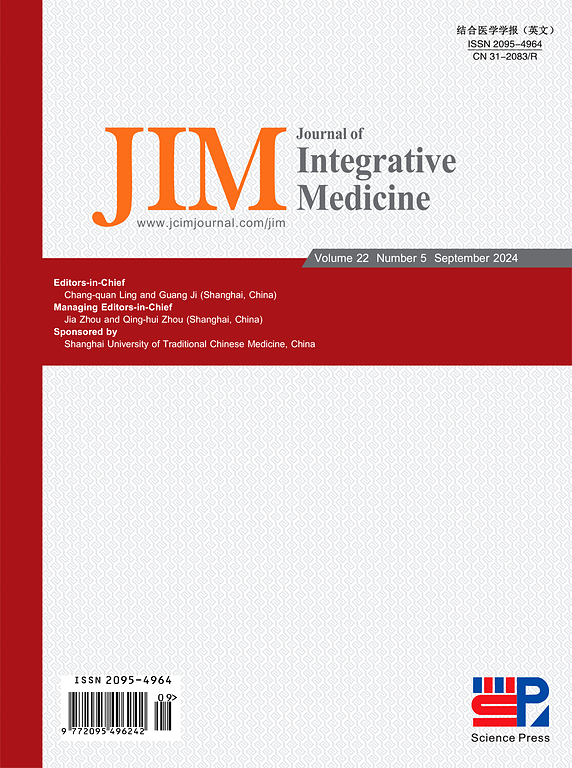针刺与新鲜胚胎移植后活产率的关系:基于不同倾向评分方法的队列研究。
IF 4
2区 医学
Q1 INTEGRATIVE & COMPLEMENTARY MEDICINE
引用次数: 0
摘要
目的:采用不同倾向评分法探讨针刺控制性卵巢过度刺激(COH)与活产率(LBR)的关系。方法:在这项回顾性队列研究中,将接受COH的符合条件的妇女分为针灸组和非针灸组。主要结局是LBR,由倾向评分匹配(PSM)决定。LBR被定义为胚胎移植后一个或多个胎龄超过28周的活婴的分娩。倾向得分模型包含16个混杂变量。为了验证结果,使用另外三种倾向评分方法进行敏感性分析:倾向评分调整、逆概率加权(IPW)和带有“双鲁棒”估计器的IPW。结果:主要队列纳入9751例患者,其中针灸组1830例(18.76%),非针灸组7921例(81.23%)。在1:1 PSM后,针灸组的LBR更高(41.4% [755/1824]vs 36.4%[664/1824],比值比为1.23[95%可信区间,1.08-1.41])。另外三种倾向评分方法产生了本质上相似的结果。两组患者发生严重不良事件的风险无显著差异。结论:这项回顾性研究揭示了针灸与COH患者LBR增加之间的关联,并且针灸是一种安全且有价值的治疗选择。郑晓燕,蒋志强,李玉婷,李春林,朱华,于志,于思思,杨丽丽,唐思义,Lü杨晓燕,梁福荣,杨杰。针刺与新鲜胚胎移植后活产率的关系:基于不同倾向评分方法的队列研究。集成医学[J];打印前Epub。本文章由计算机程序翻译,如有差异,请以英文原文为准。
Association between acupuncture and live birth rates after fresh embryo transfer: A cohort study based on different propensity score methods
Objective
To explore the association between acupuncture during controlled ovarian hyperstimulation (COH) and the live birth rate (LBR) using different propensity score methods.
Methods
In this retrospective cohort study, eligible women who underwent a COH were divided into acupuncture and non-acupuncture groups. The primary outcome was LBR, as determined by propensity score matching (PSM). LBR was defined as the delivery of one or more living infants that reached a gestational age over 28 weeks after embryo transfer. The propensity score model encompassed 16 confounding variables. To validate the results, sensitivity analyses were conducted using three additional propensity score methods: propensity score adjustment, inverse probability weighting (IPW), and IPW with a “doubly robust” estimator.
Results
The primary cohort encompassed 9751 patients (1830 [18.76%] in the acupuncture group and 7921 [81.23%] in the non-acupuncture group). Following 1:1 PSM, a higher LBR was found in the acupuncture cohort (41.4% [755/1824] vs 36.4% [664/1824], with an odds ratio of 1.23 [95% confidence interval, 1.08–1.41]). Three additional propensity score methods produced essentially similar results. The risk of serious adverse events did not significantly differ between the two groups.
Conclusion
This retrospective study revealed an association between acupuncture and an increased LBR among patients undergoing COH, and that acupuncture is a safe and valuable treatment option.
Please cite this article as: Zheng XY, Jiang ZY, Li YT, Li CL, Zhu H, Yu Z, Yu SY, Yang LL, Tang SY, Lü XY, Liang FR, Yang J. Association between acupuncture and live birth rates after fresh embryo transfer: A cohort study based on different propensity score methods. J Integr Med. 2025; 23(5):528–536.
求助全文
通过发布文献求助,成功后即可免费获取论文全文。
去求助
来源期刊

Journal of Integrative Medicine-Jim
Medicine-Complementary and Alternative Medicine
CiteScore
9.20
自引率
4.20%
发文量
3319
期刊介绍:
The predecessor of JIM is the Journal of Chinese Integrative Medicine (Zhong Xi Yi Jie He Xue Bao). With this new, English-language publication, we are committed to make JIM an international platform for publishing high-quality papers on complementary and alternative medicine (CAM) and an open forum in which the different professions and international scholarly communities can exchange views, share research and their clinical experience, discuss CAM education, and confer about issues and problems in our various disciplines and in CAM as a whole in order to promote integrative medicine.
JIM is indexed/abstracted in: MEDLINE/PubMed, ScienceDirect, Emerging Sources Citation Index (ESCI), Scopus, Embase, Chemical Abstracts (CA), CAB Abstracts, EBSCO, WPRIM, JST China, Chinese Science Citation Database (CSCD), and China National Knowledge Infrastructure (CNKI).
JIM Editorial Office uses ThomsonReuters ScholarOne Manuscripts as submitting and review system (submission link: http://mc03.manuscriptcentral.com/jcim-en).
JIM is published bimonthly. Manuscripts submitted to JIM should be written in English. Article types include but are not limited to randomized controlled and pragmatic trials, translational and patient-centered effectiveness outcome studies, case series and reports, clinical trial protocols, preclinical and basic science studies, systematic reviews and meta-analyses, papers on methodology and CAM history or education, conference proceedings, editorials, commentaries, short communications, book reviews, and letters to the editor.
Our purpose is to publish a prestigious international journal for studies in integrative medicine. To achieve this aim, we seek to publish high-quality papers on any aspects of integrative medicine, such as acupuncture and traditional Chinese medicine, Ayurveda medicine, herbal medicine, homeopathy, nutrition, chiropractic, mind-body medicine, taichi, qigong, meditation, and any other modalities of CAM; our commitment to international scope ensures that research and progress from all regions of the world are widely covered. These ensure that articles published in JIM have the maximum exposure to the international scholarly community.
JIM can help its authors let their papers reach the widest possible range of readers, and let all those who share an interest in their research field be concerned with their study.
 求助内容:
求助内容: 应助结果提醒方式:
应助结果提醒方式:


